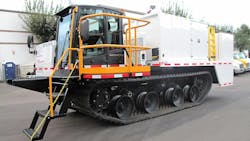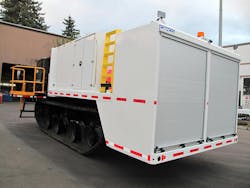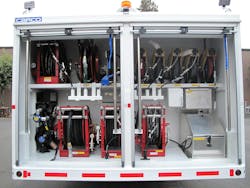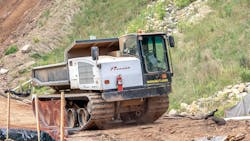When my organization, Carco Industries, first started mounting service bodies on tracked carriers back in 2011, we were venturing into new territory. As a company that had been building truck bodies with a wide range of truck-mounted equipment since 1973, we were experts at working with conventional chassis. But the unique opportunities presented by a large copper mining operation would challenge us to think differently about how we approached vehicle upfitting.
Opportunity knocked
The customer needed to service equipment on leach pads—massive, engineered structures where microscopic gold and copper are extracted from ore using chemical solutions. Traditional wheeled service trucks were problematic because their high ground pressure was actually reducing extraction rates by compacting the material. They needed a low ground pressure solution that could carry the same service bodies and equipment we’d typically mount on a conventional truck.
I have a tried-and-true process that I’ve developed over my 35-plus years of selling capital equipment, and it paid off here as well. In my formula, the fleet defines the duty, the duty defines the body and the body then defines the chassis. Working my way through that process led me to start looking at tracked crawler carriers and specifically at the Prinoth 3000 GT, the predecessor to today’s Prinoth Panther T12.
What we discovered was that tracked carriers offered an ideal solution. The C-channel frame rails and spacing matched what we were used to working with on commercial trucks. This meant we could adapt our existing body designs without a complete engineering overhaul. It was like working with a conventional truck chassis, just one that happened to run on tracks instead of wheels.
That first project involved mounting a fuel and lube body for day-to-day maintenance operations at the mine. The body needed to carry diesel fuel, DEF, various lubricants and recovery tanks for used fluids. The main technical challenge wasn’t the physical mounting—it was integrating with the carrier’s power system. Unlike a conventional truck with a transmission PTO, the tracked carrier uses a hydrostatic drive system with a multi-port gearbox. We had to develop a clutching mechanism to engage and disengage our hydraulic systems from the available accessory port.
On the right track
The mining company was very pleased, and the success of that initial build led us to explore other applications. We’ve since mounted articulating cranes, flatbeds and hook-lift systems—all on crawler carrier platforms. The hook-lift configuration has been particularly interesting, as it allows customers to use one prime mover with multiple body options. Given the significant investment in a tracked carrier, this broad versatility helps justify the cost.
For body builders considering this market, there are some important considerations. First, these aren’t simply off-road variants of conventional trucks. While the mounting interface is familiar, the applications are unique. You’re building for environments where roads don’t exist and never will. This influences everything from material choices to maintenance access points.
The bodies need to be built more robustly than their on-road counterparts. Mining environments, in particular, can be incredibly harsh. When you’re dealing with chemicals like sulfuric acid used in copper leaching, material selection becomes critical. We’ve also learned to incorporate more vibration isolation and flexible mounting systems to handle the different dynamics of a tracked vehicle.
Not for every body
From a business perspective, entering this market requires some risk tolerance. The initial engineering investment can be significant, and you won’t achieve the same margins you might see with conventional truck bodies—at least not initially. However, once you develop the expertise, there’s less competition and strong customer loyalty. These customers tend to be more focused on capability and reliability than initial cost.
We’ve found success by treating these projects as collaborative problem-solving exercises. For example, we work closely with mining customers to understand their specific maintenance requirements and environmental constraints. This has led to innovations like spring-mounted tanks to handle terrain flexing and enhanced access systems to meet strict safety requirements.
One of our most successful adaptations has been our approach to mounting systems. We use a combination of vulcanized rubber and steel products between the frame rail of the chassis and the long soles of the body, along with cradle-type mounts featuring spring relief. This allows the chassis frame to flex without transferring that movement to the body and tanks. In high-speed off-road applications, this isolation system has proven crucial for long-term durability.
Safety considerations have also driven innovation. For instance, we’ve developed comprehensive access systems including pull-down ladders, platforms and handrails that allow operators to maintain three points of contact while accessing the equipment. These features are particularly important in mining operations where MSHA regulations must be met.
The flexibility of these platforms has opened up new opportunities in various sectors. Power transmission line contractors, for example, are using tracked carriers with hook-lift systems to transport multiple specialized bodies to remote locations. This eliminates the need for building temporary access roads, saving both time and environmental impact.
The future of this market segment looks promising. Beyond mining, we’re seeing increased interest from utility companies needing to access remote infrastructure and environmental services firms working in sensitive areas. The ability to carry conventional truck bodies into unconventional locations creates opportunities that simply didn’t exist before.
A lot riding on it
For body builders considering this market, my advice is to start with a thorough understanding of the carrier platform. With a bare chassis weight of 28,793 lbs and a gross vehicle weight rating (GVWR) of 57,900, the Panther T12 is a brute. With its 250-horsepower CAT C7.1 diesel engine and hydrostatic drive system, it has plenty of power to move a load, even on challenging terrain, but it’s not just about the T12’s strength and hauling capacity. You need to understand a crawler carrier’s remarkable climbing ability, its center of gravity limitations, hydraulic system integration requirements and operator access considerations.
But where it really differentiates itself is in its ground-handling capabilities. The T12 exerts only about 3.5 psi of ground pressure when unloaded and 6.2 psi fully loaded—that’s less pressure than a person walking. Plus, with a top speed of 8.4 miles per hour, it can cover ground quickly while carrying full loads. The 29.5-in-wide metal-embedded rubber tracks and high-travel suspension system let it handle just about any ground condition you can throw at it, from deep mud to rocky terrain.
It’s also important to recognize that while the mounting interface might be familiar, the operating environment is completely different. Design decisions need to account for ground clearance, vehicle articulation and the fact that these units often work on significant grades of up to 60% or 30 degrees, on virtually all types of terrains and in up to six feet of water. Also keep in mind that what works perfectly well on a conventional truck might need substantial modification for a tracked application.
One aspect that’s particularly relevant for body builders is the width consideration. While highway trucks need to stay within standard vehicle width restrictions, tracked carriers often work in environments where overall width is less critical. This can actually provide more flexibility in body design, allowing for features that might not be practical on a road-going truck.
Looking ahead, I expect we’ll see continued evolution in this segment. The increasing focus on environmental protection and the need to access ever more remote locations will drive demand for these specialized vehicles. For body builders willing to invest in understanding this market, it represents a significant opportunity to expand beyond conventional truck-mounted applications.



